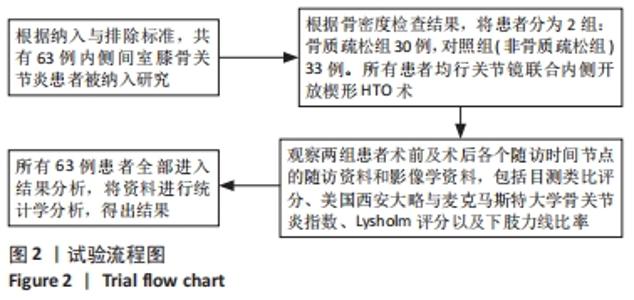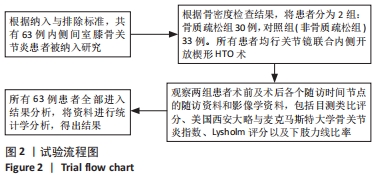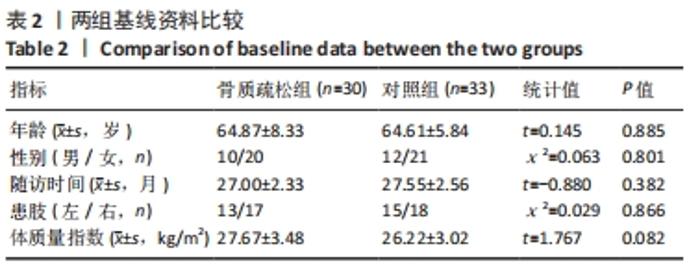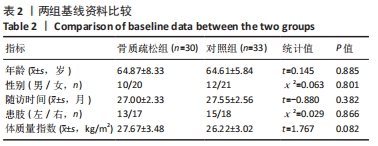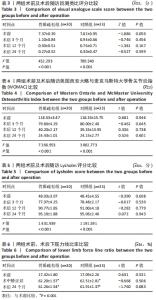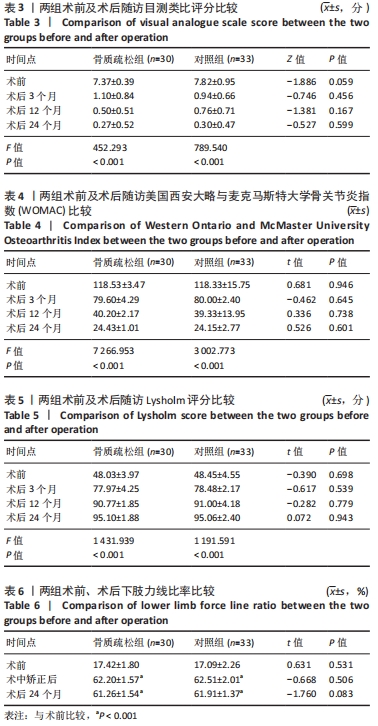[1] VINA ER, KWOH CK. Epidemiology of osteoarthritis: literature update. Curr Opin Rheumatol, 2018;30(2):160-167.
[2] WEBER AE, BOLIA IK, TRASOLINI NA. Biological strategies for osteoarthritis: from early diagnosis to treatment. Int Orthop. 2021;45(2):335-344.
[3] MAHEU E, BANNURU RR, HERRERO-BEAUMONT G, et al. Why we should definitely include intra-articular hyaluronic acid as a therapeutic option in the management of knee osteoarthritis: Results of an extensive critical literature review. Semin Arthritis Rheum. 2019;48(4):563-572.
[4] 张卫超, 姜磐, 崔卫国, 等. 玻璃酸钠腔内注射联合关节镜清理术治疗退行性膝骨关节炎的效果及安全性观察[J]. 临床误诊误治,2021,34(2):34-38.
[5] 管乐,康宁.PGA/PLA支架材料对膝骨关节炎组织工程软骨重建的影响[J].海南医学院学报,2019,25(24):1841-1846.
[6] TANG X, WANG S, ZHAN S, et al. The Prevalence of Symptomatic Knee Osteoarthritis in China: Results From the China Health and Retirement Longitudinal Study. Arthritis Rheumatol. 2016;68(3):648-653.
[7] SHARMA L, SONG J, FELSON DT, et al. The role of knee alignment in disease progression and functional decline in knee osteoarthritis. JAMA. 2001;286(2):188-195.
[8] BROUWER RW, HUIZINGA MR, DUIVENVOORDEN T, et al. Osteotomy for treating knee osteoarthritis. Cochrane Database Syst Rev, 2014;(12):D4019.
[9] 许健, 郭标, 马炜, 等. 胫骨内侧高位截骨术中Miniaci法与力线杆定位法矫正下肢负重力线的精确性比较[J]. 中国骨与关节损伤杂志,2020,35(6):577-580.
[10] 陈锐鸿,葛鸿庆,陈文治.单髁置换与胫骨高位截骨治疗膝关节内侧间室骨关节炎:1年随访比较[J].中国组织工程研究,2019,23(20):3143-3147.
[11] YANG TL, SHEN H, LIU A, et al. A road map for understanding molecular and genetic determinants of osteoporosis. Nat Rev Endocrinol. 2020;16(2):91-103.
[12] COMPSTON JE, MCCLUNG MR, LESLIE WD. Osteoporosis. Lancet. 2019;393 (10169):364-376.
[13] 周影,潘卫民,孙雯, 等.唑来膦酸及云克治疗骨质疏松症的疗效对比研究[J].海南医学院学报,2020,26(16):1237-1241+1249.
[14] 吴敏杰, 张宏秀, 余利鹏, 等. 骨质疏松相关因素对腰椎退变性疾病患者内固定手术预后的影响[J]. 江苏医药,2015,41(7):759-761.
[15] 吴昊, 王立新, 程兆明, 等. 骨质疏松对手术治疗女性Colles骨折预后影响的临床研究[J]. 中华全科医学,2012,10(11):1696-1698.
[16] DAMEN J, VAN RIJN RM, EMANS PJ, et al. Prevalence and development of hip and knee osteoarthritis according to American College of Rheumatology criteria in the CHECK cohort. Arthritis Res Ther. 2019;21(1):4.
[17] JEON HM, CHOI EB, HEO JH, et al. Influence of the initial foot contact strategy on knee joint moments during stair and ramp descent. Sci Rep. 2020;10(1):13922.
[18] ABHISHEK A, DOHERTY M. Diagnosis and clinical presentation of osteoarthritis. Rheum Dis Clin North Am. 2013;39(1):45-66.
[19] JACKSON JP, WAUGH W. Tibial osteotomy for osteoarthritis of the knee. J Bone Joint Surg Br. 1961;43-B:746-751.
[20] 孙健, 韩晓峰, 戴士峰, 等.胫骨高位截骨术后并发症的研究进展[J]. 河南外科学杂志,2020,26(4):155-158.
[21] SEUNG MR, HODONG N, OOG JS. Comparison of open wedge high tibial osteotomy versus unicompartmental knee arthroplasty for medial compartment arthrosis with kissing lesion. Asia Pacif J Sports Med. 2017;9(C):36.
[22] SHERMAN C, CABANELA ME. Closing wedge osteotomy of the tibia and the femur in the treatment of gonarthrosis. Int Orthop. 2010;34(2):173-184.
[23] SEO SS, KIM OG, SEO JH, et al. Complications and Short-Term Outcomes of Medial Opening Wedge High Tibial Osteotomy Using a Locking Plate for Medial Osteoarthritis of the Knee. Knee Surg Relat Res. 2016;28(4):289-296.
[24] SAITO T, KUMAGAI K, AKAMATSU Y, et al. Five- to ten-year outcome following medial opening-wedge high tibial osteotomy with rigid plate fixation in combination with an artificial bone substitute. Bone Joint J. 2014;96-B(3):339-344.
[25] FUJISAWA Y, MASUHARA K, SHIOMI S. The effect of high tibial osteotomy on osteoarthritis of the knee. An arthroscopic study of 54 knee joints. Orthop Clin North Am. 1979;10(3):585-608.
[26] KETTELKAMP DB, WENGER DR, CHAO EY, et al. Results of proximal tibial osteotomy. The effects of tibiofemoral angle, stance-phase flexion-extension, and medial-plateau force. J Bone Joint Surg Am. 1976;58(7):952-960.
[27] MARTAY JL, PALMER AJ, BANGERTER NK, et al. A preliminary modeling investigation into the safe correction zone for high tibial osteotomy. Knee. 2018; 25(2):286-295.
[28] 罗湘杭,周若玙.骨质疏松的病因及发病机制研究进展[J]. 山东大学学报(医学版), 2021,59(6):10-15.
[29] 张程, 吴忠书, 李子祺, 等.膝骨关节炎与骨质疏松症的相关性研究进展[J]. 中国骨质疏松杂志,2021,27(4):618-624.
[30] HERRERO-BEAUMONT G, ROMAN-BLAS JA, BRUYERE O, et al. Clinical settings in knee osteoarthritis: Pathophysiology guides treatment. Maturitas. 2017;96:54-57.
[31] AL SJ, SAYED ME, MONSEF N, et al. The Prevalence and the Determinants of Musculoskeletal Diseases in Emiratis Attending Primary Health Care Clinics in Dubai. Oman Med J. 2016;31(2):117-123.
[32] OHSAWA T, SHIOZAWA H, SAITO K, et al. Relation between the stand-up test and gait speed, knee osteoarthritis, and osteoporosis using calcaneal quantitative ultrasound - Cross-sectional study. J Orthop Sci. 2016;21(1):74-78.
[33] 朱正亚,郑欣,赵凤朝, 等.膝骨性关节炎与骨质疏松相关性研究概述[J].中国骨质疏松杂志,2017,23(10):1372-1375.
[34] BURNETT WD, KONTULAINEN SA, MCLENNAN CE, et al. Knee osteoarthritis patients with more subchondral cysts have altered tibial subchondral bone mineral density. BMC Musculoskelet Disord. 2019;20(1):14.
[35] KARVONEN RL, MILLER PR, NELSON DA, et al. Periarticular osteoporosis in osteoarthritis of the knee. J Rheumatol. 1998;25(11):2187-2194.
[36] 张英泽, 李存祥, 李冀东, 等.不均匀沉降在膝关节退变及内翻过程中机制的研究[J]. 河北医科大学学报,2014,35(2):218-219.
[37] 王娟, 于滕波, 郑占乐, 等.膝关节骨关节炎病理机制的研究进展[J]. 河北医科大学学报,2019,40(10):1237-1238.
[38] PAOLA P, MARIA DR, FRANCESCO C, et al. Major osteoporotic fragility fractures: Risk factor updates and societal impact. World J Orthop. 2016;7(3):171-181.
|
